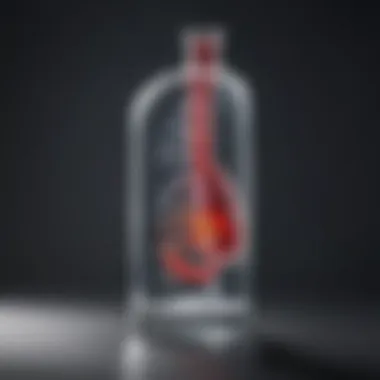Nebulized LABA: Comprehensive Insights and Applications


Intro
The field of respiratory medicine has evolved significantly over the past few decades. One of the breakthroughs in this area is the use of nebulized long-acting beta agonists (LABAs). These compounds have shown to be effective in managing chronic respiratory diseases such as asthma and COPD. The therapeutic benefits of nebulized LABAs hinge on their unique pharmacological properties, which allow for sustained bronchodilation and improved airflow in patients. Understanding these medications is vital for healthcare professionals and researchers alike.
In this article, we will delve into the recent advances in nebulized LABA technology, examining clinical applications, dosing guidelines, and potential side effects. Our discussion will draw on recent studies and data to provide an inclusive perspective on how nebulized LABAs can enhance patient outcomes and alter current approaches to respiratory therapy.
Recent Advances
Recent developments in understanding and employing nebulized LABAs have transformed their role in respiratory care. These advances manifest through both latest discoveries in clinical outcomes and technological innovations that improve delivery mechanisms.
Latest Discoveries
Numerous clinical trials have underscored the efficacy of nebulized LABAs. Studies indicate that patients receiving nebulized treatment experience a marked reduction in symptoms. For instance, a study published in the Journal of Allergy and Clinical Immunology demonstrated that nebulized LABA therapy significantly improved lung function in patients with moderate asthma. Such findings highlight the vital role of nebulized LABAs in providing long-term control of symptoms, which is crucial in managing chronic respiratory conditions.
Technological Innovations
The technology behind nebulization has also seen significant enhancements. Modern nebulizers provide finer aerosol particles that facilitate deeper lung penetration. Devices like the PARI eFlow and the Omron NE-C801 are examples of nebulizers that deliver LABA with greater efficiency. These advancements not only improve medication delivery but also enhance patient adherence to treatment protocols due to their ease of use.
"The integration of advanced nebulization technology reshapes the landscape of asthma and COPD treatments, pushing the boundaries of patient care through efficacious delivery of nebulized LABAs."
Methodology
Understanding the evidence supporting the clinical applications of nebulized LABAs requires a precise methodology. This section outlines the research design and data collection techniques employed in recent studies.
Research Design
Most studies focus on randomized controlled trials that compare nebulized LABAs against placebo groups. This design helps in determining the effectiveness of these medications based on objective clinical endpoints, including lung function tests and symptom questionnaires. Such rigorous frameworks ensure that findings are both reliable and valid.
Data Collection Techniques
Data collection varies across studies but commonly includes:
- Patient-reported outcome measures: These surveys assess symptoms and overall quality of life.
- Spirometry tests: These tests quantify lung function, providing direct measurements of improvement in respiratory capability.
- Adverse event reporting: This technique tracks side effects to evaluate safety profiles.
Each of these approaches contributes to a comprehensive understanding of the role of nebulized LABAs in therapy, guiding clinical decisions moving forward.
Prolusion to Nebulized LABA
Understanding nebulized long-acting beta agonists (LABAs) is essential in the context of respiratory care. The importance of this topic lies in the critical role that LABAs play in managing chronic respiratory conditions, particularly asthma and Chronic Obstructive Pulmonary Disease (COPD). By analyzing the use of nebulized LABAs, healthcare professionals can appreciate their benefits and implications for patient care.
Nebulized LABAs facilitate the delivery of medication directly to the lungs. This leads to an enhancement in the overall therapeutic effect while minimizing systemic exposure. The unique delivery method of nebulization allows for greater efficacy in patients who may struggle with conventional inhalers, providing an alternative route for medication administration.
In recent years, the understanding of how nebulized LABAs work has expanded, bridging the gap between pharmacology, clinical practice, and patient outcomes. Moreover, the growing body of research surrounding nebulized therapies underscores their relevance in modern respiratory medicine.
Definition and Overview
Nebulized LABAs are medications used in the management of respiratory disorders. These agents act on beta-adrenergic receptors, primarily influencing bronchial smooth muscle. They promote relaxation of these muscles, leading to bronchodilation. Nebulization allows these medications to be vaporized into a mist, which patients inhale through a nebulizer.
The use of LABAs is typically reserved for long-term control of asthma and COPD symptoms. These medications do not act as rescue inhalers and are not for acute symptom relief. Their mechanism of action and sustained bronchodilation effect make them valuable in maintaining lung function over time.
Historical Context
The development of nebulized LABAs represents a significant advancement in respiratory therapies. Long-acting beta agonists were introduced in the late 20th century. Salmeterol was one of the first LABAs to be commonly used as a nebulized treatment option. The efficacy of nebulized LBAs was initially recognized in clinical settings where patients demonstrated improved lung function and reduced exacerbation rates.
Over the years, clinical guidelines and practices surrounding the use of nebulized LABAs have evolved. Research has continued to reinforce their place in therapy while investigating the benefits against potential risks. The ongoing exploration of this field reflects a commitment to optimizing patient care and improving outcomes for individuals with chronic respiratory conditions.


In summary, understanding the significant role of nebulized LABAs in respiratory management offers insights into current treatment protocols and future clinical practice improvements.
Pharmacology of LABAs
The pharmacology of long-acting beta agonists (LABAs) is crucial in understanding their role in respiratory therapy. LABAs deliver sustained bronchodilation, providing significant relief for patients suffering from chronic respiratory conditions like asthma and COPD. Delving into the pharmacological aspects helps to elucidate the benefits, considerations, and therapeutic implications of these agents.
Mechanism of Action
LABAs exert their effects primarily through the stimulation of beta-2 adrenergic receptors located on the smooth muscle cells of the airways. When activated, these receptors initiate a cascade of intracellular events.
- Smooth muscle relaxation: This leads to bronchodilation, improving airflow and alleviating symptoms such as wheezing and shortness of breath.
- Reduced airway hyperreactivity: LABAs can minimize the sensitivity of the airway to various triggers, which is especially beneficial in asthma.
- Anti-inflammatory effects: They may exert indirect actions by modulating inflammatory responses within the airway, further enhancing their overall efficacy.
It is essential for healthcare providers and researchers to understand these mechanisms to optimize treatment regimens and improve patient outcomes.
Pharmacokinetics and Pharmacodynamics
The pharmacokinetic properties of LABAs influence their clinical application. These agents typically demonstrate a prolonged half-life, allowing for once or twice daily dosing. This extended action contributes to improved adherence among patients. Key factors in pharmacokinetics include:
- Absorption: LABAs achieve rapid absorption through the respiratory tract, leading to quicker onset of action compared to oral options.
- Distribution and metabolism: Following administration, they distribute rapidly within systemic circulation. Most LABAs undergo hepatic metabolism, primarily through the cytochrome P450 system.
- Excretion: Renal elimination is a critical pathway for these medications, making patient renal function an important consideration during treatment.
In pharmacodynamics, the efficacy of LABAs relates directly to receptor binding and activation. The dose-response relationship can determine therapeutic effects versus potential side effects.
In summary, understanding the pharmacology of LABAs—including their mechanism of action and their pharmacokinetics—is vital. This knowledge provides the foundation for effective clinical applications and ensures optimal patient care.
Clinical Applications
The topic of clinical applications is crucial in understanding how nebulized long-acting beta agonists (LABAs) fit within therapeutic regimes for respiratory conditions. This section delves into specific diseases like chronic obstructive pulmonary disease (COPD) and asthma, assessing how these medications improve patient outcomes. Recognizing the appropriate backgrounds for LABA use enables healthcare professionals to tailor treatments according to individual patient needs. The integration of LABAs into pulmonary therapy exemplifies advancements in respiratory care, emphasizing efficacy and patient quality of life.
Chronic Obstructive Pulmonary Disease
Chronic obstructive pulmonary disease represents a progressive lung condition characterized by airflow limitation. The use of nebulized LABAs shows significant benefits in managing this condition. LABAs, such as Salmeterol and Formoterol, work effectively by relaxing bronchial smooth muscle, leading to improved airflow.
Studies indicate that these medications can help reduce exacerbations and enhance pulmonary function in patients with moderate to severe COPD. Regular use of nebulized LABAs in combination with corticosteroids can optimize management strategies. A major advantage is their prolonged action, providing symptom relief over an extended period.
"Integrating nebulized LABAs into COPD treatment plans can significantly attenuate symptom severity, improving day-to-day activities for patients."
However, careful consideration of patient-specific factors, such as frequency of exacerbations and comorbid conditions, is essential in crafting a personalized treatment plan. Regular follow-up is recommended to monitor efficacy and adjust dosages as necessary.
Asthma Management
Asthma is a chronic inflammatory disorder of the airways that can be triggered by various stimuli. Nebulized LABAs serve as a valuable adjunct to inhaled corticosteroids in controlling asthma symptoms. They can address nocturnal symptoms and improve overall control of the disease when used appropriately.
When integrated into a patient's management plan, nebulized LABAs help prevent nighttime awakenings and decrease rescue inhaler usage. This ultimately allows for a more stable asthma control, leading to a better quality of life. Evidence underscores the importance of utilizing nebulized formulations in specific patient populations, particularly children and individuals who struggle with traditional inhalers.
The safety profile of LABAs has been a topic of discussion. Recent guidelines suggest using these agents only in combination with inhaled corticosteroids to minimize potential risks. Monitoring patient responses and adherence closely remains vital to achieving optimal management outcomes in asthma care.
Other Respiratory Conditions
Aside from COPD and asthma, nebulized LABAs have roles in treating other respiratory conditions, such as bronchiectasis and cystic fibrosis. In bronchiectasis, LABAs help alleviate symptoms associated with bronchial constriction and promote better airflow. Their extended action can complement other therapeutic modalities, enhancing overall management strategies.
In cystic fibrosis, nebulized LABAs can assist in overcoming symptoms linked to airway obstruction. The combination of LABAs with other agents, such as mucolytics, can improve treatment outcomes. Employing these medications within a comprehensive approach can reduce hospitalizations and improve lung function.
Administration Techniques
Understanding the administration techniques for nebulized long-acting beta agonists (LABAs) is a crucial component of optimizing therapy in respiratory conditions. Effective administration techniques can significantly influence the therapeutic outcomes for patients. The utilization of nebulizers, dosing guidelines, and patient education are essential factors that healthcare professionals must consider.
Nebulizer Types and Functionality


Nebulizers are devices that convert liquid medication into aerosol form for inhalation. There are several types of nebulizers, including jet nebulizers, ultrasonic nebulizers, and mesh nebulizers. Each type has its own distinct functionality:
- Jet Nebulizers: These are the most common type. They use compressed air to generate a fine mist. They are effective for a wide range of medications, including nebulized LABAs.
- Ultrasonic Nebulizers: These use high-frequency sound waves to create aerosol. They are quieter and more portable but usually not suitable for all medications.
- Mesh Nebulizers: These utilize a vibrating mesh to generate aerosols. They are compact and efficient but can be more costly compared to the other types.
It is important to select the appropriate nebulizer based on patient needs, medication compatibility, and desired outcomes. The functionality of these devices can greatly impact how well the medication reaches the lungs, which is critical for patient effectiveness.
Dosing Guidelines
When prescribing nebulized LABAs, dosing guidelines must be adhered to carefully. Proper dosing is vital to ensure both efficacy and safety. Typically, the dosing of LABAs is based on the specific medication, the severity of the condition, and individual patient factors.
- Generally, doses range from once or twice daily depending on the formulation.
- It is essential to monitor the patient’s response to dosing and adjust accordingly.
- Additionally, combination therapies with inhaled corticosteroids may require adjusted dosages.
Dosing should always be accompanied by a comprehensive assessment of whether the therapy is achieving the desired clinical outcomes.
Patient Education for Effective Use
Patient education is paramount in ensuring optimal outcomes with nebulized LABA therapy. Patients must be well-informed about how to properly use nebulizers and adhere to dosing schedules.
Key elements of an effective education program include:
- Demonstrating the Proper Use of Nebulizers: Patients should be shown how to assemble the nebulizer device and how to clean it after each use to prevent contamination.
- Instructions Regarding Medication: It is crucial to convey when and how often the medication should be ingested.
- Recognizing Side Effects: Patients need to be informed about possible side effects and when to seek medical attention.
Educating patients fosters compliance and enhances their ability to manage their respiratory conditions effectively.
Proper administration techniques enhance patient outcomes and can greatly reduce the frequency of exacerbations in chronic respiratory diseases.
Efficacy and Outcomes
The efficacy of nebulized long-acting beta agonists (LABAs) is crucial for understanding their role in respiratory therapy. A thorough analysis of their outcomes can shed light on patient benefits and potential optimization strategies. This section will explore the significance of efficacy in treatment plans and how it influences patient management in chronic respiratory diseases. The understanding of outcomes not only facilitates clinical decisions but also shapes future research directions related to LABAs.
Evidence from Recent Studies
Recent studies contribute significant insight into the efficacy of nebulized LABAs. Data indicate that these agents are effective in improving lung function and reducing exacerbation rates in patients with chronic obstructive pulmonary disease (COPD) and asthma. A systematic review published in the journal Chest highlighted that patients using nebulized LABAs experienced improved peak expiratory flow rates compared to those on placebo.
In one randomized controlled trial, patients receiving nebulized formoterol reported improved quality of life scores. Furthermore, a meta-analysis examined multiple studies and confirmed that nebulized LABAs significantly reduce the frequency of hospital admissions due to acute exacerbations. It's important to note that results may vary depending on individual patient characteristics, such as age, severity of disease, and concurrent treatments.
Comparative Efficacy with Other Treatments
Comparative efficacy studies position nebulized LABAs against other treatment modalities. For instance, they are often evaluated against inhaled corticosteroids (ICS) and other bronchodilators. While LABAs provide long-lasting bronchodilation, ICS is more effective in reducing inflammation. Combining these agents can yield superior outcomes. Studies suggest that patients using a combination therapy of a LABA and ICS exhibit better symptom control than those receiving either agent alone.
Additionally, nebulized LABAs are compared to dry powder inhalers and metered-dose inhalers. Evidence indicates that nebulized LABAs may offer advantages for patients who struggle with proper inhalation techniques.
Overall, understanding the efficacy of nebulized LABAs in relation to other treatment options is essential. It allows clinicians to tailor therapy based on individual patient needs, ensuring optimal treatment outcomes.
"The choice of treatment should consider not only the efficacy of the drug but also the specific patient circumstances and preferences."
In summary, evaluating the efficacy and outcomes of nebulized LABAs emphasizes their role in improving respiratory conditions. Continued research in this field will enhance our knowledge, leading to better patient management strategies.
Safety Profile and Side Effects
Understanding the safety profile and potential side effects of nebulized long-acting beta agonists (LABAs) is vital for healthcare professionals and patients alike. These considerations can significantly influence patient adherence to therapy and overall treatment outcomes. Side effects are not merely inconveniences; some can lead to serious health implications, making risk assessment and management essential components of respiratory care. Therefore, this section of the article critically examines the common side effects of nebulized LABAs and the risk management strategies that can be adopted to mitigate them.
Common Side Effects
Long-acting beta agonists are generally well-tolerated, but they are not devoid of adverse effects. Some common side effects associated with nebulized LABAs include:


- Tachycardia: This is an increased heart rate, which can be uncomfortable for patients and may lead to additional complications in those with pre-existing heart conditions.
- Palpitations: Patients may experience an awareness of their heartbeat, which could cause anxiety and discomfort.
- Tremors: Fine motor tremors can occur and, while they are usually transient, can be bothersome.
- Hypokalemia: This is a decrease in potassium levels in the blood, potentially leading to muscle weakness or arrhythmias.
- Headaches: Some individuals report experiencing headaches, which can disrupt daily activities.
"Awareness of side effects empowers patients to report any issues, enabling healthcare providers to adjust treatment accordingly."
While most side effects are manageable, it is crucial for healthcare professionals to educate patients on what to expect and when to seek further advice. Understanding these side effects promotes informed decision-making and can enhance treatment adherence.
Risk Management Strategies
When using nebulized LABAs, implementing risk management strategies is essential to minimize side effects. Considerations include:
- Patient Education: Educating patients about potential side effects empowers them to recognize early symptoms and seek medical advice when necessary.
- Regular Monitoring: Performing routine assessments can help identify any negative changes in patient health early, allowing for timely interventions.
- Dosing Adjustments: Individualized dosing may reduce intolrnace to side effects. Clinicians can consider tapering doses or switching to another treatment class.
- Combination Therapy: In some cases, combining LABAs with inhaled corticosteroids may allow for lower doses of each drug, potentially reducing adverse effects.
- Utilizing Spacer Devices: For those who might experience irritation or discomfort, the use of a spacer device can deliver the medication more effectively and reduce systemic exposure.
Adopting these strategies ensures that healthcare professionals can provide a more holistic and responsive approach to managing the safety profile of nebulized LABAs. This not only improves patient safety but also enhances the overall quality of care.
Current Research and Advances
The exploration of nebulized long-acting beta agonists (LABAs) continues to evolve, and recent research plays a critical role in defining their place in respiratory medicine. Understanding Current Research and Advances in this field is essential for health professionals, as it guides clinical practice, informs treatment protocols, and fosters ongoing developments in drug formulations. This section delves into innovations in formulation and future directions in LABA research, highlighting their significance and implications.
Innovations in Formulation
Innovative approaches to the formulation of nebulized LABAs have emerged as a critical area of study. These advancements aim to optimize drug delivery and effectiveness.
- Nanoparticle Technology: This technique enhances the bioavailability of nebulized medications by improving the pharmacokinetic profile.
- Dual-Action Formulations: Such formulations combine LABAs with inhaled corticosteroids, providing comprehensive management for asthma and COPD.
- Personalized Dosage Forms: Research is steering towards custom formulations that cater to the specific needs of individual patients, based on their response to the medication.
These innovations are imperative in ensuring that medications not only reach the targeted site effectively but also maintain a sustained therapeutic effect that aligns with the patient's needs. As these formulations progress through clinical trials, they offer an optimistic outlook for improved patient outcomes.
Future Directions in LABA Research
The trajectory of LABA research is poised to tackle several pressing considerations. Future studies will likely focus on:
- Long-Term Safety Profiles: Evaluating the long-term use of services like LABAs versus traditional treatments will provide insights into efficacy and adverse reactions over time.
- Genetic Factors: Understanding how genetic variations influence patient response could enhance personalized medicine approaches.
- Combination Therapies: Investigating combinations with other classes of drugs may yield synergistic effects that could revolutionize asthma and COPD treatments.
Ongoing research efforts will shape the landscape of how LABAs are implemented in clinical settings. The importance of aligning pharmacological properties with real-world applications cannot be overstated.
"Advancements in nebulized LABA formulations are a pivotal step towards personalized respiratory care, enhancing both safety and efficacy in treatment."
Epilogue
The topic of nebulized long-acting beta agonists (LABAs) is critical to modern respiratory therapy. This article illustrated the significance of these pharmacological agents in effectively managing chronic respiratory conditions such as asthma and chronic obstructive pulmonary disease (COPD). By examining both clinical efficacy and safety profiles, healthcare professionals can make informed decisions in treatment pathways. Understanding how nebulized LABAs function is essential for optimizing patient outcomes.
Summary of Key Points
- Definition: Nebulized LABAs are inhaled medications that provide long-lasting relief from respiratory symptoms.
- Pharmacological Mechanism: They work by relaxing bronchial smooth muscles, leading to improved airflow.
- Clinical Applications: Primarily indicated for asthma and COPD, they serve as a primary or adjunct treatment option.
- Dosing Guidelines: Following prescribed dosing is crucial, as improper use can lead to adverse effects.
- Safety Profile: While generally safe, monitoring for side effects remains essential, particularly with extended use.
- Current Research: Innovations in formulation and delivery methods aim to enhance efficacy and minimize risks.
Implications for Practice
The findings of this article highlight various implications for practice in respiratory care. The integration of nebulized LABAs into treatment regimens should be based on individual patient evaluations. Clinicians must stay updated with current research to provide evidence-based care, tailoring treatments according to specific patient needs. Education on the proper use of nebulizers is also crucial. Providing patients with clear guidance ensures adherence to treatment, improving long-term outcomes. Overall, a thorough understanding of nebulized LABAs within clinical settings can significantly enhance patient quality of life.
Key Studies and Literature
This section will succinctly present pivotal studies that have shaped our understanding of nebulized LABAs. Significant randomized controlled trials and meta-analyses will be highlighted, providing a glimpse into how these publications have explored efficacy, safety, and optimal dosing.
- Blease, C. G. et al. studied the impact of nebulized formoterol on asthmatic patients, offering insights into dosing variations and their effects on symptoms.
- Johns, D. et al. conducted meta-analyses comparing nebulized LABAs with inhaled corticosteroids, revealing vital data about long-term management strategies.
- Gardiner, L. et al. reviewed the safety profiles of different LABA formulations, shedding light on common adverse events and patient management implications.
These pivotal pieces of literature illustrate the evolution in understanding how nebulized LABAs operate in various clinical contexts.
Further Reading Suggestions
For readers seeking to expand their knowledge beyond this article, a compendium of further reading suggestions is invaluable. These resources include books, current guidelines, and leading journals that focus on respiratory medicine:
- Global Initiative for Asthma (GINA): Offers updated treatment guidelines and recommendations for asthma management, including LABA use in nebulized forms.
- Cochrane Database of Systematic Reviews: Features systematic reviews on the efficacy of nebulized therapies, providing robust evidence and statistical analyses.
- Respiratory Medicine Journal: Publishes peer-reviewed articles focusing on advances in pulmonary therapies, including the role of nebulized LABAs.
- Book: "Pharmacology for Respiratory Care": A comprehensive resource detailing medications used in respiratory therapy and their implications for clinical practice.
These materials not only enhance comprehension but promote a deeper inquiry into the subject matter central to respiratory care.















